Economic Developers: Ignore the Glitz! Focus on What Matters
By The Economic Development Curmudgeon
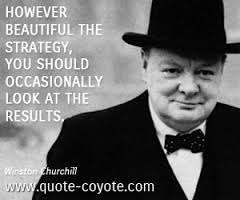 Last month’s issue, “What the heck is going on in Local Economic Development 1″ was very well-received. It seemed the better part of wisdom to follow up with a second issue on that topic. The core idea behind this series of articles is to help local economic developers navigate and function effectively within their communities–sort of on-the-job helpful advice. The concepts are borrowed from a sub-discipline of political science, public policy-making, which studies how “policies” are developed, approved and implemented. The first issue introduced the reader to elements of the local economic development context. In this issue, we deepen our understanding of the Policy/Practitioner World. Using two concepts introduced in the last month’s issue (“Strategies, Tools, and Programs” and the Policy and Practitioner Worlds”), we will also introduce a new concept: “the policy cycle”. That will be plenty for this month.
Last month’s issue, “What the heck is going on in Local Economic Development 1″ was very well-received. It seemed the better part of wisdom to follow up with a second issue on that topic. The core idea behind this series of articles is to help local economic developers navigate and function effectively within their communities–sort of on-the-job helpful advice. The concepts are borrowed from a sub-discipline of political science, public policy-making, which studies how “policies” are developed, approved and implemented. The first issue introduced the reader to elements of the local economic development context. In this issue, we deepen our understanding of the Policy/Practitioner World. Using two concepts introduced in the last month’s issue (“Strategies, Tools, and Programs” and the Policy and Practitioner Worlds”), we will also introduce a new concept: “the policy cycle”. That will be plenty for this month.
Let’s tackle the new concept first so we can weave other elements into it. The Policy Cycle For our purposes, “policies” can be broadly defined to suit our purposes. Public policy-making, in the words of a classic textbook by James Anderson, involves getting things done which “involve conflict and struggle among people with conflicting interests, values and desires” (p. 2). That covers a lot of territory, yet it pretty much hits our nail on the head. To be fair, Anderson and public policy-making both center on government and politics–and in most communities getting things done in economic development reaches into both government and politics. But no fear, all this does not get us into the Democratic/Republican stuff or the Progressive/Conservative stuff either. That will come in a later, much later issue. Essentially, getting something done is a “process”–a string of activities which culminate hopefully in successfully getting your initiative accomplished and it’s hoped-for results actually achieved. That process is the “policy cycle”. Public policy-making breaks down this “getting something done process” into five discrete stages or phases. That is the “policy cycle”.
The five stages are: (1) identify/define the problem needed to be fixed, and get the issue on the agenda of decision-makers relevant to your initiative; (2) formulating or deciding what your initiative/proposal will do, design the elements of the program, and dealing with any alternatives to your proposal; (3) get your initiative approved or adopted by the decision-makers; (4) implementing the program or administration of your initiative to effectively accomplish its mission, strategy, or purpose; and (5) evaluation–is the initiative actually accomplishing what it was intended to accomplish and if not what should be done about its deficiencies or how do we take it to the next step.
I suspect the policy cycle seems like commonsense to most readers, but don’t underestimate what the policy cycle implies. Simply coming up with a great idea (from a panel at a conference or blog, for example) and trying to get it started in your EDO can set you up for a career-ending disaster. I may sound naive, but success comes more often if the program/project/initiative is soundly designed, professionally advocated, and consistently implemented. In any event, the policy cycle breaks down the different elements required to put together your initiative, get it approved, and then put it to work in a program or project. Since the first stage (problem identification and agenda-setting) is complex, and most crucial, I suggest we leave discussion on this “stage” for another day and another issue. Included in this first stage is an economic development plan (it also overlaps with the second stage), and that is only one of several big-time elements. Let’s postpone the first stage for now.
Today, I want to use concepts introduced in the first issue–Policy and Practitioner Worlds and strategy, tools, and programs–and see how they fit into the policy cycle.
The Policy Cycle and the Policy World
The Policy and Practitioner Worlds approach the policy cycle with different objectives and perspectives, but each tends to specialize or concentrate on specific policy stages. In this section, I will discuss how the Practitioner works with the Policy World in the early stages of developing an idea or initiative for your community. So let’s start by describing how things happen in a typical economic development organization. You might be surprised to know that numerically most Practitioner economic developers work in an EDO with five or less staff. Practitioners work, sad to say, in somewhat isolated settings, or administer your program in a larger diversified department (a chamber, planning or development, for example) or in the city manager’s/mayor’s office. Not only are you likely to be more or less on your own, but you rarely come into contact with economic developers outside your community. There may be other communities down the interstate-but one hardly ever talks to them.
In this atmosphere, ideas and initiatives usually are drawn from outside sources (or from your boss–ugh), and these probably started from the latest hot book, attending a conference panel, surfing the web, reading a blog, newspaper report or journal. Younger economic developers arriving new on the job often are pre-programmed with their professor’s approach/perspective or armed with a research project used for a seminar paper. Without you realizing it, by using these ideas the Policy World has intruded into the Practitioner World. Suggesting ideas and strategies is what the Policy World does best–at least they think so. It is likely by doing that you have let the Policy World handle key parts of the policy cycle’s first stage–and that is potentially really bad news for you.
A pure Policy World idea most likely is not ready for prime time in your community. Like water from a stream flowing down a mountain–you should boil it before you drink it. Policy Worlders don’t live where you live; they live in an academic discipline, economics for instance, or follow the guidelines of their profession, like planning. They usually are attacking some cosmic problem, and although they would be the last to admit it, their ideas strongly reflect a partisan and ideological value system. They hide all this behind math and statistics, models and theory–all of which prove conclusively their idea is brilliant. Questioning a statistical correlation is rather pointless conversation, so don’t even try. Policy World ideas are written in broad strokes. Their model or idea applies to and can be used by everybody no matter city size, politics, state or economic base–one size fits all. Like a good pair of shoes, one needs to customize them to the world you live in.
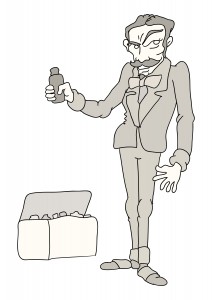 Although we have not talked about the first stage, problem definition, defining the problem in terms and situations that fit your community is essential. The Policy World person is thinking about a one size fits all for every community in the nation–not one that fits yours. Secondly, just by bringing in a number of people and letting them participate in developing the idea builds support and buy in, which will be important in later stages. Handing someone a fiat accompli designed by someone else–not good. Opportunity wasted. Maybe the good idea will spawn an even better idea from someone else. Maybe someone will tell you they hate the idea and will fight it tooth and nail. It’s probably important to know that at the beginning. There’s a third problem, Policy Worlders think in terms of what I would call “strategies” (economic gardening is an excellent example). Economic gardening is not a program–it is not customized to your community–and, as shall be discussed below—may require tools (essential resources, specialized expertise, critical powers) not available within your EDO. In this case economic gardening may be a great strategy, but you have to do the dirty work and figure out specifically what they means for a program in your community.
Although we have not talked about the first stage, problem definition, defining the problem in terms and situations that fit your community is essential. The Policy World person is thinking about a one size fits all for every community in the nation–not one that fits yours. Secondly, just by bringing in a number of people and letting them participate in developing the idea builds support and buy in, which will be important in later stages. Handing someone a fiat accompli designed by someone else–not good. Opportunity wasted. Maybe the good idea will spawn an even better idea from someone else. Maybe someone will tell you they hate the idea and will fight it tooth and nail. It’s probably important to know that at the beginning. There’s a third problem, Policy Worlders think in terms of what I would call “strategies” (economic gardening is an excellent example). Economic gardening is not a program–it is not customized to your community–and, as shall be discussed below—may require tools (essential resources, specialized expertise, critical powers) not available within your EDO. In this case economic gardening may be a great strategy, but you have to do the dirty work and figure out specifically what they means for a program in your community.
Again, the point I am trying to make is that Practitioners tend to get their ideas and program/project innovations from external sources. The idea and its insight might be great, but Policy Worlders do not design programs. For the most part they are oblivious to the issues of program implementation. Their work is more strategy-like, their action plan designed for a power point and forty-five minute lectures–not for an unfriendly legislature or hostile tax payers. It doesn’t matter that the initiative really, really seems to be exactly what your community needs. Perhaps the bottom line to the Two Worlds and Policy Cycle relationship in the early stages of the policy cycle is the observation that the Policy World revolves around ideas, disciplines/theories and strategies–the Practitioner World orbits around people, institutions, tools, and processes–these are two different worlds. The two tied together can be powerful, but it doesn’t often happen by accident.It may be–but the Practitioner needs to have a serious conversation with herself, and others, before proceeding further. The initiative, the idea, needs to be customized to your policy cycle–and should be rejected if it is not likely to make it successfully to the end. One should pick one’s battles thoughtfully. The consequences of failing can be serious indeed. Also, winning a bitter too-divisive battle can create enemies who live to fight another day.
If you really want to go ahead with the concept, than concentrate on formulating a proposal/designing a program that attacks real issues in your community and can make it through your community’s policy cycle. Essentially, we have outlined a way a Practitioner can take an idea/initiative from the Policy World, but adapt it, customize it, and start bringing in others very early on to help meaningfully in starting the initiative. There are risks in this–but my experience is that sooner or later risks have to be dealt with anyway.
Strategies, Tools and Programs: the elements of an successful initiative
OK. Let’s move on to another subject. In the last issue I introduced the distinction between strategy, tool and program. Let’s follow up on that and sharpen it a bit.
In developing your initiative for your community, the Practitioner might profit if she understands that the deal is to convert a strategy into a program—BUT–only if your EDO has access to the “tools” that are needed to successfully implement the program. Every strategy requires or relies on certain “tools” relevant to the strategies. Programs are how strategies get carried out, but programs fail or appear trivial to potential clients/media/decision-makers IF they are not believable. Possessing the right “tools” makes them believable. In this section, I want to concentrate on how important “tools” are–and provide the reader a better sense of just what a “tool” is and how does one get one’s hands on the tools needed to implement the strategy/program.
STRATEGIES:
Strategies are goal-oriented. Strategies often dominate an economic development plan. When the media calls for an interview, you usually will talk strategies with them. When your staff, legal counsel, or the client walks in the room, however, no one talks strategy–you start talking “programese and toolese”. That is because strategies are calls to action which, at root, provide a rationale why and for whom you are engaging in an economic development activity. For example, Business Retention is a common strategy–assist the firms already in your community and make sure (1) they don’t leave and (2) they prosper as best they can. 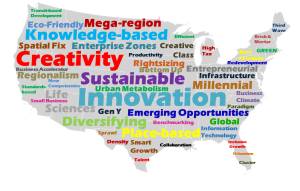 Notice that this definition is rather general. It doesn’t say which firms, when, or how to assist them–and it includes two competing definitions for retention (prosper and don’t leave). The strategy will not provide that kind of detail but will more than likely say why it is important to preserve your existing economic base–and build upon it (that’s the prosper).
Notice that this definition is rather general. It doesn’t say which firms, when, or how to assist them–and it includes two competing definitions for retention (prosper and don’t leave). The strategy will not provide that kind of detail but will more than likely say why it is important to preserve your existing economic base–and build upon it (that’s the prosper).
Strategies are meant to be general. Strategies are important in the formulation stage for sure, but are even more important in stage one–problem identification and agenda-setting. Somewhere in the strategy you might want to say how the strategy addresses the problem everybody is worried about–and you may want to use wording and rationale to ensure that it gets noticed (favorably) by those that make the decision to go forward and those who are affected by it. In other words, strategies have purposes other than simple problem-solving. Simply saying that most new jobs are created by companies in your existing economic base may be true a good rationale for starting a business retention program–but it is not the program. In other words, a strategy jump starts the initiative off, motivates decision-makers and constituencies, and justifies the overall program.
Strategies, therefore, are inherently “political”, “rhetorical”, “inspirational”–and they are linked to solving an acknowledged community problem. Without defining each, some of the most commonly used local economic development strategies are: business retention/economic gardening and attraction (often linked, but don’t have to be), business climate (usually at state level), tourism (or people attraction), physical development (greenfield) or redevelopment, physical infrastructure, workforce and skills development, small business and entrepreneurism. There are others, of course, but before you add to the list, wait until we finish this section–many readers will be tempted to add “programs” or even “tools” to the list, thinking they are strategies.
TOOLS:
Before we discuss programs, however, we next need to understand tools. A one-cylinder sports car is a lawnmower. Tools are the engine behind the strategy. A program without the horsepower invites laughter and cynicism. Your program follows from the tools you have available for use. So, you decide on a strategy, the next step is to figure out what tools are needed to achievable whatever it is the strategy seeks to accomplish. Every strategy requires at least one tool, most more than one. Putting the program before the tool is literally putting the cart before the horse. Choosing a strategy involves a good understanding of what tools are essential to the strategy’s effective implementation. Absence of a tool relevant and essential to a strategy or program is a red light–stop right there and go onto the next project or find another strategy.
The most common tools in use today are: tax abatement, guarantees and credits, bond issuance (both tax exempt and taxable), eminent domain, land use powers, authority to “write down” investment-asset, industry/sector/management business expertise, a tourist destination or event, marketing expertise and credibility, asset (land and property) ownership/management/lease/sale capacity, capital (as in revolving loan fund, venture capital, grant), available staff, construction management capacity, regulatory powers (essential to business climate), curriculum and relevant expertise (skills training or entrepreneurism), access to membership. ability to advocate policy effectively. A tool can be legal authority to own property. The search for tools necessary and/or appropriate to your strategy and program ought to bring you back to really basic structural issues–not the mere “strengths and weaknesses” (SWAT) which usually go into program design. If you have no one with marketing skills on staff, do you really want to start an attraction program?
The temptation is to use the tools at hand and try to make them fit the strategy. In that strategies usually require several tools, searching through available tools isn’t necessarily bad–but before you construct a program, you need to separate out the available tools to determine if they don’t fit into the strategy. Next, figure out how you need to customize the tool in order to achieve the strategy. Some tools can’t easily be customized for all sorts of reasons, and that can make them inappropriate to your strategy. For example, a tax abatement to a pizza restaurant only makes Mexican restaurants mad. Tax abatement really doesn’t work well for start ups, for example because most taxes are on profits and start ups usually don’t make a profit. So the tax abatement tool maybe be available but does not fit the clientele involved in the program–and customization may not be easy.
Tools, and who operates the tools are vital to your strategy and structuring your program. A workforce EDO could easily assume responsibility in their strategy for using tools (K-12 schools/community college) controlled by others. Another example, a chamber is not going to engage in waterfront revitalization–it cannot acquire sites through eminent domain. One final example phrased in a question–should a government department attempt a business assistance strategy by itself?
Some tools are powerful, but are also quite controversial. Their use is likely to generate opposition, media attention and even legal counteraction. Think eminent domain and tax abatement. Sometimes issuing tax exempt bonds can cause a stir. No pain, no gain. Some strategies just don’t work without these powerful tools. You can talk about a strategy of waterfront revitalization and everybody cheers–and then you mention eminent domain and tax abatement and the rats leave the sinking ship. If you “control” the tool, understand how it is used, time frames involved, resources required–and the effect of all this on your decision-makers and constituents. If a powerful/controversial tool is essential-don’t think you can bluff your way–plan on using it when necessary.
If you don’t control a required tool, you need to identify who does and make them a partner. If you are a chamber, and you want to start up a business attraction program, like it or not, sooner or later, its going to involve incentives such as tax abatement–which only your local government can approve. Your EDO in that instance does not control a necessary tool to close a major attraction deal. In this case, you can gather all the leads you want, but closing the deal is someone else’s job. Knowing that is essential in developing the program and measuring its success.
Tools can be a double-edged sword. Tools often determine the occupational mix found on your EDO staff. If one wants to use eminent domain–better have access to lots of lawyers. Want to lend money? Banking and financial people are essential. Want to manage/sell/construct/lease property–better have the right skills in your staff. The specialized skills associated with tools, however, can cut two ways–they can help you and hurt you. Not all bankers can operate a venture capital or equity program. A construction engineer used to dealing with trade unions in construction projects may not be suitable for other strategies. An EDO dominated one type of occupation essential to its primary tool may form its own “personality” and “bureaucratic style” that fits some strategies and programs better than others–think about the “soft” side of tools and how they fit into the program.
When I said you should understand your tools, also understand that tools directly and indirectly can define your EDO and shape its operation, mentality, and behavior–and the perceptions of outsiders. EDOs are built around the tools they possess–I wasn’t kidding. Try adding a new tool to your EDO and see the problems that follow.
Programs:
Economic developers are familiar with programs. They are the meat and potatoes of our job. A program puts specificity into a strategy–and it should be constructed around tools you control or have firm agreements with other EDOs to access. So our business retention program will be targeted for certain size or specific industry/sector firms. It will involve a visitation program, a survey and inventory for a database, and will focus on a specialized loan fund whose terms and conditions are salient and attractive to the targeted firms. In this instance, the tools of (1) available staff with relevant expertise, (2) an appropriate RLF, (3) a database capacity, and the (4) existence of targeted firms in your economic base (don’t laugh–cluster development implies targeting something you have little of). An attraction program involves media placement, advertising, database and information marketing capacity, maybe access to site selectors and industry groups, and a staff to qualify and process leads. It might help to possess an attractive product that somebody actually wants (i.e. your city). We will concentrate on programs in future months, but for now my message is that the program is last to be designed–after a problem is identified, strategy chosen, tools identified.Then one figures out the terms and conditions, the eligibility, the collateral material,, etc. necessary to implement the initiative. Knowing your tools sets parameters for program design.
So hopefully, the reader has a better idea of what’s a strategy, tool or program–now we ask ….
How Do We Use this Stuff?
 The ultimate utility of these concepts is that they break down complex tasks (doing economic development in your community, starting a new initiative) into elements which can be structured and sequenced. No one eats a pizza with one bite. These concepts provide an “order” and a “perspective” so that things can make more sense. Using these concepts you can create a “system” and a process. You can “structure” your decision-making.
The ultimate utility of these concepts is that they break down complex tasks (doing economic development in your community, starting a new initiative) into elements which can be structured and sequenced. No one eats a pizza with one bite. These concepts provide an “order” and a “perspective” so that things can make more sense. Using these concepts you can create a “system” and a process. You can “structure” your decision-making.
It is obvious, different things happen at each stage and different “players” are important. So as we design a new initiative, it is, of course, logical to concentrate on what it takes to succeed in the stage du jour, but one should do so knowing what lies ahead. One can better see the bridges that one should not burn, and if one realizes that success of the initiative is not its mere passage or approval, but rather its successful implementation then dead-end streets (like starting a program without the necessary tools) should be avoided.
So far, we have stressed that our profession is quite diverse (Two Worlds) and that we don’t all see things from the same vantage point. In fact, we usually define economic development differently–and economic developers can be their own worst enemies/ best friends. It might be evident that the two worlds intersect unevenly at various points in the policy cycle. We earlier learned that the Policy World, even without our realizing it, can dominate the early stages of the policy cycle (program definition and problem identification)–and that could be dangerous.
Failure to place the Policy World strategy or idea in the context of your community wastes opportunities and poorly defined/designed programs fail to attack the problem as it manifests itself in your community. The Practitioner should not be led down the primrose path by the Policy World in the early stages of the policy cycle. It is critical that problems, strategies, and program design be customized to the needs and culture evident in your community. I know I said this earlier, but repeating twice only means I need to repeat it once more. Customizing ideas and strategies to fit your community is what you get paid for. If the idea doesn’t seem like it will survive your community’s policy cycle–then see what can.
A successful program is not one that secures a favorable newspaper article, but rather a program that works in the implementation stage. Effective Program design and a believable linkage to relevant definition of the community’s problem are the minimum required for successful implementation. If you haven’t access to the right tools, don’t bother with the strategy, however attractive it might be to you. Your first job is to gain access to the right tools. How do you gain access to the right tools, you ask? There are obviously several different ways. First, you can develop the tool. This is easiest if the tool is “expertise” based. If you want an effective small business counseling or entrepreneurial assistance program than hiring the right person/people is the first step. They can help formulate an effective program with their expertise. If you can’t hire until you get post-approval funding, then borrow the expertise. But acquiring the expertise (tool) comes first.
Some tools, usually the most powerful ones, however, require state/city council approvals, and often generate legal battles and can involve judicial review. Eminent domain and some forms of bond issuance, tax abatement are examples of powerful, but controversial tools. A lot of these “powerful tool” battles have already been fought, but it does alert the reader that trying to develop your own tool should involve your legal counsel or city attorney. Some types of EDOs may not possess the legal authority to operate property or lease it, or generate income through fees, or lend in the case of an RLF. Tool acquisition can easily touch upon your state’s not-for-profit law or IRS prohibitions. The point under discussion is that having identified essential tools required to implement a desired strategy, you may discover that there are reasons why your agency does not have the tools.
Perhaps the easiest way to acquire a tool is through partnership–a joint or multi-EDO initiative. Strategies usually require access to several tools–for example another key tool essential to an effective small business or entrepreneurial program (aside from small business expertise) is easy access to your customer–who when made aware of your initiative will see it in a positive light. A partnership with the chamber of commerce would convey legitimacy and provide access. This is why SBA programs try to work closely with chambers. The chamber might say no, however, particularly if you are a government agency with no visible access to appropriate expertise. They might say no just because they don’t like you. They might say no because the structure of the proposed partnership is ambiguous or unattractive. In any of these instances, it is better to have resolved these issues previous to your unilateral announcement that you have started some small business or entrepreneur program that may become marginal, isolated and doomed to failure.
Developing a tool is one thing, creating a tool quite another. For some strategies, tourism for example, creating a tool can be a wonderful strategy. An event, a farmer’s market, working with a not-for-profit to establish a historical site, or a winery are all examples of tool creation. An event, an historical site, or a tourist destination can be a tool of the tourism program. An industrial park is a tool as well; so is setting up an RLF. In theory, creating a tool is a gift that keeps on giving, year in and year out. A tool can be expanded to serve many strategies, and grown in scale as well. In short, the absence of a tool is as much opportunity as problem.
So once again we have mercifully arrived at the conclusion.
It is probably apparent at this early stage in developing our theme that much still has to be discussed. We are laying the foundations at this point and things are somewhat general and not especially glitzy. That is the point. The glitz in the profession is talking about strategies, devising new and exciting initiatives and programs which address the problem du jour which the Policy World alleges plague our communities. The profession is great at talking, and planning, and blogging, and starting new, bold and “relevant” programs and initiatives–that go no where and accomplish little–except diminish our profession in the eyes of the community we serve. The thrust of our article/series is to move from the glitz–concentrate on making programs work–concentrate on developing programs that address concerns felt and experienced by your community. Let’s shift the profession from one dominated by strategizers and talkers, to one dominated by successful doers.

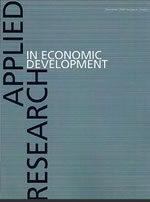


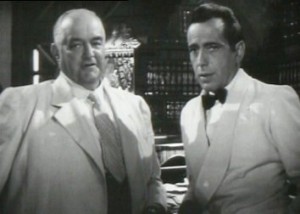
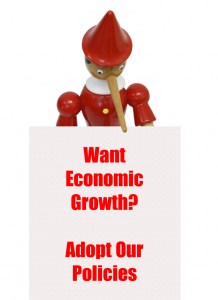
Comments
As one who has wkd in the E.D. field 20+ yrs in various roles, incl. publishing in journals or as a blogger, I find a great misunderstanding in basic planning terms & concepts involving the abuse & misuse of the “economic development” term.
Those who dominate the planning field (urban planners), followed by commercial real estate interests, Chambers of Commerce, architects, attorneys, marketers, EDOs, politicians, etc. have never worked in our field, that is, as Community Economic Development practitioners. Their whole focus is on the built environment on the private sector side, and they have done so using heavily subsidized public funds, but where are the corresponding public goods? What we see is the mixing of apples with oranges, intermingling terms to the point where the private sector uses public terms for their benefit. There is no such thing as “private sector economic development”; it’s like saying the City of Toledo is a private sector entity because they now have their own construction company. It doesn’t make sense.
Economic development & business development are NOT one & the same thing. For those wanting to support or advocate for the built environment & private sector development, go to the Chambers of Commerce, as this is their mission in life. On the public sector side, “economic development” exists to “move the needle” in socioeconomic terms, i.e. standards-of-living & quality-of-life outcomes. What we are lacking, other than a complete misunderstanding of basic conceptual planning terms, are the metrics which go along with seeing socioeconomic progress, considering that the public sector spends tens of millions annually in the name of “economic development”, yet we continue to see structural & generational poverty. To add insult to injury, our business pages report a “healthy economy” & “strong growth trends”, never mind that we see widening income disparities and deep poverty growing at alarming rates.
I also notice that we never see an actual operational definition of “economic development”. In San Antonio, Tx where I live, our E.D. Dept spends tons of public funds to promote business development, but they don’t have a definition of what constitutes “economic development”. Why? Because they are satisfied that what our Chambers of Commerce deem successful in business/commercial terms, as good enough. Obviously, our public sector officials work for the Chambers, but who is working for the citizens who pay their salaries? I repeat, WHO is working for the citizens who pay their salaries?
I leave you with two favored quotes, the first: “An economic development program does not economic development make.” Anonymous. And the second, “Anyone who declares success based on intangible benefits for a project that has not come even close to performing economically as expected should have their salary in intangible benefits.” Michael Eglinski, city auditor, Lawrence, Kansas.
Unless you’ve worked in the CED field, you do not work in the economic development field, you actually work for the Chambers of Commerce; one has expertise in the public sector, the other in the private sector.
Let’s not mix conceptual apples with transactional oranges. Thank you.
Comment by Fernando Centeno, CED on May 14, 2015 at 5:47 pm
The comments are closed.